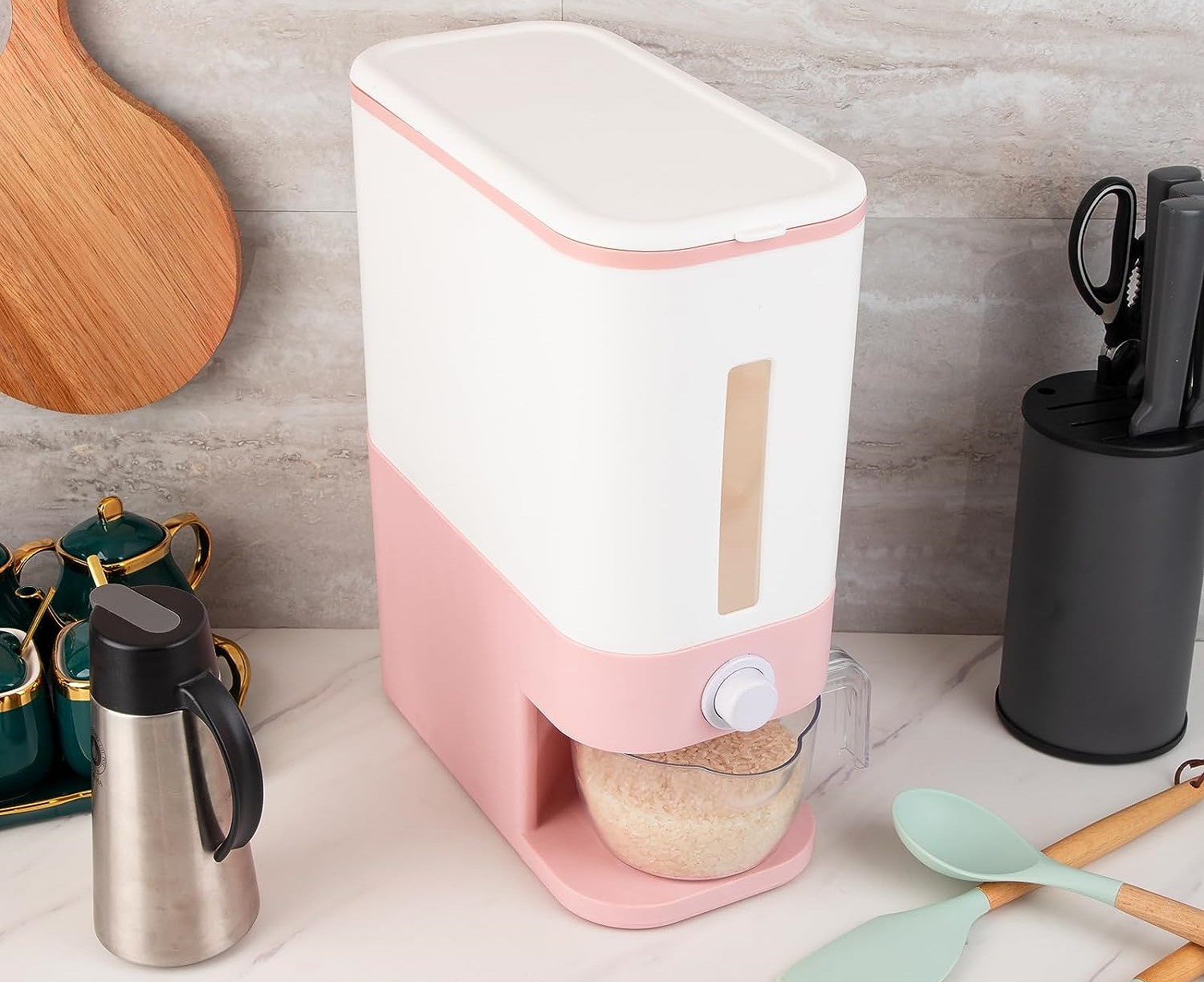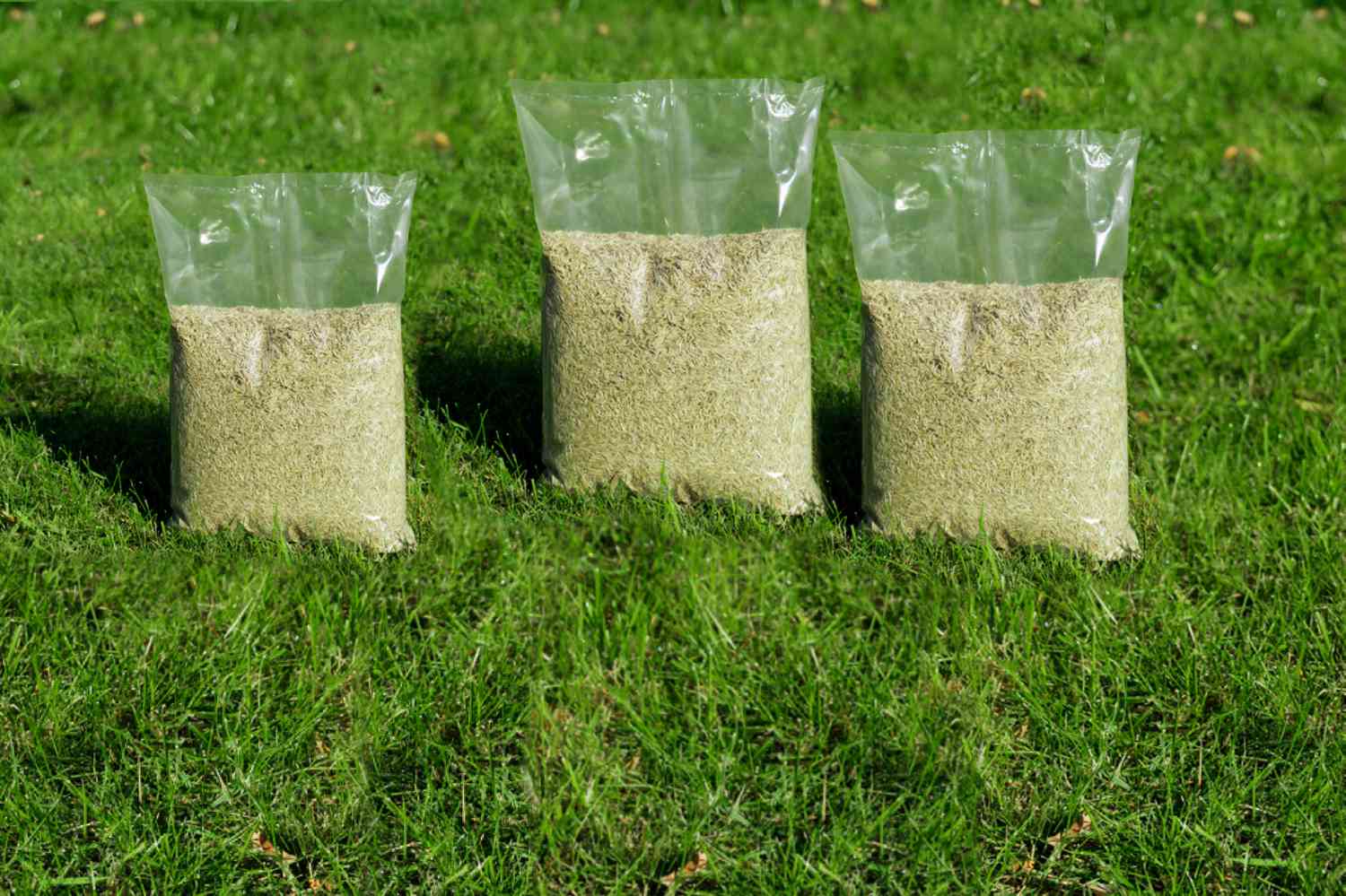

Articles
How To Store 25 Lbs Of Rice
Modified: April 23, 2024
Discover the best way to store 25 lbs of rice with our informative articles. Learn how to keep your rice fresh and your pantry well-stocked.
(Many of the links in this article redirect to a specific reviewed product. Your purchase of these products through affiliate links helps to generate commission for Storables.com, at no extra cost. Learn more)
Introduction
Storing a large quantity of rice can be a smart and practical decision for many individuals and families. Not only is rice a staple food around the world, but it also has a long shelf life and is incredibly versatile in the kitchen. Whether you are looking to be prepared for emergencies, save money by buying in bulk, or simply enjoy the convenience of having a ready supply of rice on hand, knowing how to store 25 lbs of rice properly is the key to preserving its freshness and quality.
In this article, we will explore the benefits of storing rice, factors to consider before storing, choosing the right containers, preparing rice for storage, different methods for storing rice in bulk and smaller portions, recommended storage locations, how to monitor and maintain rice storage, checking for quality and freshness, as well as using stored rice in everyday cooking.
By following the tips and guidelines provided in this article, you will be able to store your rice effectively and enjoy its many benefits for months, if not years, to come.
Key Takeaways:
- Storing 25 lbs of rice offers benefits such as emergency preparedness, cost savings, and food security. Proper preparation, storage, and monitoring ensure high-quality rice for long-term use.
- Choosing the right containers, preparing rice for storage, and utilizing it in everyday cooking are essential for effective rice storage. With proper care, stored rice can provide convenience and cost savings for the future.
Read more: How To Store 25 Lbs Of Flour
Benefits of Storing Rice
Storing rice has several benefits that make it a worthwhile practice for individuals and families. Here are some of the key advantages:
- Emergency Preparedness: Rice is a non-perishable food item with a long shelf life, providing a valuable source of nutrition during emergencies and natural disasters.
- Cost Savings: Buying rice in bulk quantities and storing it can help save money in the long run. Purchasing larger quantities often comes at a lower cost per pound, and by buying during sales or promotions, you can maximize savings.
- Convenience: Having a supply of rice readily available in your pantry eliminates the need for frequent trips to the grocery store. This can be particularly helpful during busy times or when access to stores is limited.
- Versatility: Rice is a versatile ingredient that can be used in a myriad of dishes, from stir-fries and curries to soups and salads. Having a stockpile of rice allows you to effortlessly create a variety of meals.
- Extended Shelf Life: Properly stored rice can remain fresh for an extended period. This means less waste and the ability to enjoy high-quality rice even months after purchase.
- Food Security: Storing rice provides an added measure of food security. Whether you encounter unexpected financial challenges or face disruptions in the food supply chain, having a reserve of rice can provide reassurance and peace of mind.
By understanding and harnessing the benefits of storing rice, you can enjoy the convenience, cost savings, and security that come with having a well-stocked pantry.
Factors to Consider Before Storing Rice
Before you begin storing rice, there are several important factors to consider to ensure optimal storage conditions and maintain the quality of your rice. Here are some key considerations:
- Type of Rice: Different types of rice may have varying storage requirements. For example, white rice generally has a longer shelf life compared to brown rice due to its lower oil content. Take note of the specific storage recommendations for the type of rice you are storing.
- Quality of Rice: It is crucial to start with high-quality rice for long-term storage. Inspect the rice for any signs of damage, such as pests, mold, or unusual odors. Choose rice that is clean, dry, and free from any contaminants.
- Storage Duration: Consider the length of time you plan on storing the rice. If you are aiming for short-term storage (a few months), different methods may be suitable compared to long-term storage (up to a year or more).
- Climate and Environment: The climate and environment in which you live can influence rice storage. Factors such as temperature, humidity levels, and exposure to sunlight can impact the shelf life of rice. It is important to store rice in a cool, dry place away from direct sunlight and fluctuations in temperature and humidity.
- Available Storage Space: Assess the amount of storage space you have available to determine the quantity of rice you can store. Ensure that the storage area is clean, properly ventilated, and pest-free.
- Personal Consumption: Consider your family’s rice consumption habits. How frequently do you use rice in your meals? This will help you determine the amount of rice you need to store and the frequency of rotation.
- Packaging: The packaging material is an important consideration. Whether you are using the original packaging or transferring the rice to different containers, make sure they are airtight, moisture-proof, and capable of protecting the rice from pests.
By taking these factors into account, you can ensure that you are making informed decisions when it comes to storing rice, thereby preserving its quality and maximizing its shelf life.
Choosing the Right Containers for Rice Storage
When it comes to storing rice, choosing the right containers is essential for maintaining its freshness and quality. Here are some factors to consider when selecting containers for rice storage:
- Airtightness: Opt for containers that have airtight seals to prevent moisture and air from entering. This helps to preserve the quality of the rice and prevent it from going stale or becoming infested with pests.
- Material: Select containers made of food-grade materials that are durable and free from any chemicals that could potentially leach into the rice. Glass, food-grade plastic, and stainless steel are all suitable options.
- Size: Choose containers that accommodate the quantity of rice you plan to store. It’s generally best to use multiple smaller containers rather than one large container as this allows for easier rotation and reduces the risk of spoilage.
- Transparency: Opt for containers that are transparent or have a clear window. This allows you to easily see and monitor the rice without having to open the container, reducing the risk of exposing it to air and moisture.
- Ease of Use: Consider containers that are easy to open, close, and handle. This will make it more convenient for you to access and use the stored rice when needed.
- Pest-Resistant: Look for containers that are designed to be pest-resistant or consider using additional measures such as placing bay leaves or silica gel packets in the container to deter insects and pests.
- Stackability: If you have limited storage space, consider containers that are stackable. This allows you to maximize your storage area and keep the rice neatly organized.
- Labeling: It is helpful to choose containers that have a designated space for labeling. This allows you to easily identify the type of rice, storage date, and any other pertinent information.
By carefully considering these factors and selecting the right containers, you can ensure that your rice remains fresh, safe, and easily accessible for an extended period of time.
Preparing Rice for Storage
Before storing rice, it is important to properly prepare it to ensure its quality and longevity. Here are some steps to follow when preparing rice for storage:
- Clean the Rice: Thoroughly inspect the rice for any debris, such as stones or husks. Rinse the rice under cold water to remove any dust or impurities.
- Dry the Rice: After rinsing, allow the rice to dry completely. Spread it out on a clean, dry surface or use a paper towel to absorb excess moisture. Avoid storing damp rice as it can lead to mold or spoilage.
- Optional: Freeze Treatment – Although not necessary, some individuals choose to freeze the rice for a few days to kill any potential pests or insect eggs that may be present.
- Portion the Rice: Decide on the quantity of rice you want to store in each container. It is generally recommended to store rice in smaller portions rather than one large batch. This allows for easier rotation and reduces the risk of spoilage if one portion becomes compromised.
- Seal the Containers: Place the rice in your selected containers and ensure they have tight-fitting, airtight seals. This will prevent air, moisture, and pests from entering the containers and compromising the quality of the stored rice.
- Label the Containers: Take a moment to label the containers with the type of rice and the storage date. This will help you keep track of the rice’s freshness and usage, making it easier to rotate and replenish your supply as needed.
- Store in Suitable Environment: Find a cool, dry, and dark place to store your containers of rice. Avoid areas that are exposed to heat, humidity, or direct sunlight, as these conditions can negatively impact the quality and shelf life of the rice.
By following these steps to prepare your rice for storage, you can ensure that it stays fresh and maintains its quality for an extended period. Properly preparing the rice is the foundation for successful long-term storage.
Read more: How To Store 50 Lbs Of Rice
Storing Rice in Bulk
If you have a large quantity of rice and want to store it in bulk, there are specific methods you can follow to ensure its freshness and longevity. Here’s how to store rice in bulk:
- Choose the Right Containers: Select large, airtight containers that can accommodate the entire bulk quantity of rice. Ensure they are made of food-grade material and have a secure lid to prevent moisture and pests from entering.
- Divide into Portions: Even though you are storing rice in bulk, it is advisable to divide it into smaller portions. This makes it easier to use and ensures that if one portion gets compromised, the rest remain unaffected.
- Ensure Dryness: Before transferring the rice into the containers, ensure that it is completely dry. Any moisture can lead to mold and spoilage during long-term storage.
- Seal the Containers: Once the rice is divided and placed in the containers, secure the lids tightly to create an airtight seal. This will help preserve the quality and prevent any moisture or pests from entering.
- Storage Location: Find a suitable storage location for your bulk rice containers. It should be cool, dry, and away from direct sunlight. Avoid areas with fluctuating temperatures or high humidity, as they can shorten the shelf life of the rice.
- Rotate the Rice: If you are storing rice for long periods, it is important to regularly rotate the containers. This means using the older rice first and replenishing it with fresh rice. This will help you maintain a constant supply of fresh rice.
- Monitor for Quality: Periodically check the stored rice for any signs of pests, mold, or unusual odors. If you notice any issues, dispose of the affected rice and take necessary measures to prevent further contamination.
By following these steps, you can properly store rice in bulk quantities, ensuring that it remains fresh, high-quality, and ready to use whenever you need it.
Store the rice in a cool, dry place in an airtight container to prevent moisture and pests. Consider using a food-grade bucket with a tight-fitting lid for easy storage.
Storing Rice in Smaller Portions
If you prefer to store rice in smaller portions, there are several methods you can employ to maintain its freshness and convenience. Here’s how to store rice in smaller portions:
- Choose Individual Containers: Select smaller, airtight containers that can hold the desired portion of rice. Using individual containers allows for easier access and rotation of the rice.
- Portion Size: Decide on the quantity of rice you want to store in each container based on your consumption needs. Consider factors such as your family size, frequency of rice consumption, and meal planning.
- Ensure Airtight Seals: Ensure that the containers have tight-fitting lids to create an airtight seal. This helps prevent moisture, air, and pests from entering the containers and compromising the rice’s quality.
- Label the Containers: Take a moment to label each container with the portion size and storage date. This helps keep track of the freshness and enables easy identification when reaching for specific amounts of rice.
- Storage Location: Find a cool, dry, and dark place to store the individual rice containers. Avoid areas near heat sources or sunlight, as these can affect the rice’s quality. Additionally, ensure the storage area is free from pests and insects.
- Rotate the Rice: Practice rotation by using the oldest containers of rice first and replacing them with fresh ones. This ensures that the rice stays fresh and minimizes the risk of any batches going bad over time.
- Consider Freezing: If you intend to store rice for an extended period, consider freezing a portion of it. Freezing rice can help preserve its quality and extend its shelf life.
- Monitor for Quality: Regularly check the stored rice for any signs of spoilage, pests, or unusual odors. If you notice any issues, discard the affected portion and take necessary measures to prevent further contamination.
By following these steps, you can effectively store rice in smaller portions, ensuring its freshness, convenience, and ease of use in your everyday cooking.
Recommended Storage Locations for Rice
Proper storage location is crucial for maintaining the quality and freshness of rice. Here are some recommended storage locations for rice:
- Pantry or Cupboard: A cool, dry pantry or cupboard is an ideal storage location for rice. Choose an area away from direct sunlight, heat sources, and any potential moisture. This ensures a stable temperature and reduces the risk of the rice spoiling or becoming stale.
- Basement: If you have a basement that meets the necessary storage conditions, it can serve as an excellent location for rice storage. Ensure the area is dry, well-ventilated, and free from any potential contaminants.
- Cellar or Root Cellar: Cellars or root cellars are naturally cooler and offer a consistent temperature. These locations are particularly advantageous if you live in a hotter climate and don’t have access to air-conditioned storage areas.
- Utility Room: If you have a utility room with a controlled temperature and humidity, it can be a suitable storage location for rice. Just ensure that the room is clean, dry, and doesn’t experience extreme fluctuations in environmental conditions.
- Garage: While garages can be convenient for storage, be cautious when using them for rice storage. Garages can be susceptible to temperature fluctuations and humidity, which may negatively impact the quality of the rice.
- Climate-Controlled Storage: If you have access to climate-controlled storage facilities, such as a wine cellar or a climate-controlled pantry, these areas are ideal for long-term rice storage. They provide stable temperature and humidity conditions, ensuring the rice remains in optimal condition.
- Refrigerator or Freezer: Refrigerators and freezers can be used to store rice, but it’s important to note that they may alter the texture and taste of the rice. If using these appliances, ensure the rice is properly sealed in airtight containers to prevent moisture absorption and potential odors from other foods.
Remember to assess the storage conditions in these locations and choose the one that best suits your needs. Regularly monitor and maintain the storage area to ensure the rice stays fresh and of high quality throughout its storage duration.
Monitoring and Maintaining Rice Storage
Proper monitoring and maintenance of rice storage are essential to ensure that the rice remains fresh, free from pests, and maintains its quality over time. Here are some key steps to follow:
- Regular Inspection: Periodically check the stored rice for any signs of pests, such as insects or rodents, mold growth, or unusual odors. If you notice any issues, take immediate action to address and resolve them.
- Pest Control Measures: Implement preventive measures to keep pests away from the rice. This can include using pest-resistant containers, placing bay leaves or whole cloves inside the containers, or utilizing traps or natural repellents in the storage area.
- Temperature and Humidity Control: Ensure that the storage area maintains a consistent temperature and humidity level. Fluctuations in temperature or high humidity can affect the quality and shelf life of the rice. Use a thermometer and hygrometer to monitor these factors if necessary.
- Proper Ventilation: Adequate ventilation helps prevent moisture buildup and reduces the risk of rice spoilage. If storing rice in containers with airtight seals, ensure that the storage area itself is properly ventilated to maintain airflow around the containers.
- Rotate and Use the Rice: Regularly rotate the stored rice by using the older portions first and replenishing them with fresh batches. This ensures that the rice remains in constant circulation and maintains its quality.
- Keep Containers Clean: Periodically clean the containers used for rice storage to remove any residue or debris that might have accumulated. Ensure the containers are thoroughly dried before refilling them with fresh rice.
- Proper Sealing: Regularly check the seals of the containers used for rice storage to ensure they remain airtight. Replace any damaged or worn-out seals to maintain optimal storage conditions.
- Labeling and Date Tracking: Keep track of the storage dates and use-by dates by labeling the containers. This allows you to easily identify the age of the rice and prioritize its consumption accordingly.
By diligently monitoring and maintaining your rice storage, you can ensure that the rice remains safe, fresh, and of high quality for an extended period.
Read more: 25 Best Mug Warmer To Keep Your Drinks Hot
Checking for Quality and Freshness
Regularly checking the quality and freshness of stored rice ensures that you are using high-quality ingredients in your meals. Here are some key aspects to consider when checking your rice:
- Appearance: Examine the rice for any visible signs of mold, discoloration, or unusual spots. Fresh rice should have a uniform color and appear free from any blemishes.
- Texture: Cook a small sample of the rice and assess its texture. It should have a firm yet tender texture when properly cooked. Grain breakage or excessive sticking can indicate degraded quality.
- Aroma: Take a whiff of the cooked rice. It should have a pleasant, neutral scent. Any off or rancid odors could indicate that the rice has gone bad.
- Taste: Taste a small portion of the cooked rice. It should have a fresh, natural flavor without any sour or musty notes. Any off or unpleasant flavors may suggest that the rice is no longer fresh.
- Pest Infestation: Inspect the stored rice and its containers for any signs of pests, such as insects, larvae, or rodent droppings. If you notice any infestation, discard the affected rice and take measures to prevent further contamination.
- Storage Duration: Consider the duration of time the rice has been stored. While rice has a long shelf life, it is still important to adhere to recommended storage times to maintain its quality and nutritional value.
- Properly Sealed Containers: Check the seals of the rice containers to ensure they are secure and airtight. Containers with compromised seals can lead to moisture absorption and affect the freshness of the rice.
- Storage Conditions: Assess the storage area for any changes in temperature, humidity, or exposure to light. Fluctuations in these factors can accelerate spoilage and affect the quality of the rice.
By regularly checking the quality and freshness of your rice, you can ensure that it remains safe and enjoyable to consume. If you notice any signs of degradation, it is best to dispose of the affected rice and replenish it with a fresh batch.
Using Stored Rice in Everyday Cooking
Stored rice can be a convenient and versatile ingredient to incorporate into your everyday cooking. Here are some creative ways to utilize your stored rice:
- Side Dishes: Serve rice as a simple side dish alongside various main courses. Whether paired with grilled chicken, stir-fried vegetables, or sautéed shrimp, rice enhances the meal and provides a satisfying base.
- Stir-Fries: Whip up delicious stir-fries by adding cooked rice to a hot pan along with your choice of protein, vegetables, and seasonings. The rice helps absorb the flavors of the other ingredients and provides a satisfying and filling meal.
- Fried Rice: Transform leftover rice into a tasty fried rice dish. Sauté the rice with vegetables, protein, and seasonings such as soy sauce or sesame oil. Customize it with your favorite ingredients, including scrambled eggs, diced ham, or prawns.
- Rice Bowls: Create nourishing rice bowls by topping cooked rice with a variety of flavorful ingredients, such as grilled or roasted vegetables, marinated tofu, or sliced grilled meat. Drizzle with your favorite sauce or dressing for added taste.
- Soups and Stews: Enhance soups and stews by adding cooked rice. It not only adds heartiness to the dish but also helps thicken the broth and provides a satisfying texture. Consider adding rice to classic soups like chicken noodle or vegetable soup.
- Rice Pudding: Utilize rice for a sweet treat by making rice pudding. Simmer cooked rice with milk, sugar, and your choice of flavors such as cinnamon or vanilla. Serve chilled or warm for a comforting dessert.
- Rice Salads: Create refreshing rice salads by mixing cooked rice with various ingredients like chopped vegetables, herbs, and dressings. Customize it with your preferred flavors and textures, making it a great option for picnics or light lunches.
- Sushi or Rice Balls: Roll cooked rice into sushi rolls or shape them into rice balls. Fill with your favorite ingredients like seafood, vegetables, or pickles to create delightful and portable snacks or meals.
These ideas are just a starting point. Get creative in the kitchen and experiment with different recipes and cuisines to make the most of your stored rice. With a little imagination, your rice can transform into a range of delicious and satisfying dishes.
Conclusion
Storing 25 lbs of rice can provide numerous benefits, including emergency preparedness, cost savings, convenience, and food security. By following the proper guidelines and methods for rice storage, you can ensure that your rice remains fresh, high-quality, and readily available when you need it.
Before storing rice, consider factors such as the type and quality of the rice, storage duration, climate and environment, available storage space, and personal consumption habits. Choosing the right containers, whether for bulk storage or smaller portions, is essential. Opt for airtight containers made of food-grade materials that protect the rice from moisture, pests, and contaminants.
Properly preparing rice for storage includes cleaning, drying, and optionally freezing the rice to ensure its quality. Whether storing in bulk or smaller portions, find a suitable storage location such as a cool, dry pantry or cellar that is away from heat and sunlight.
Maintaining rice storage requires regular monitoring and inspection for pests, mold, and odor. Proper ventilation, temperature control, and rotation of rice containers are crucial. Check for quality and freshness by assessing the rice’s appearance, texture, aroma, and taste. Ensure that the containers are airtight and properly sealed.
When it’s time to use the stored rice, get creative in the kitchen. Use it as a side dish, in stir-fries, fried rice, soups, stews, salads, and even desserts like rice pudding. There are countless flavorful and nutritious recipes to explore.
In conclusion, storing rice in the proper conditions with care and attention to quality ensures that you have a reliable food source that can sustain you and your family. By following the guidelines in this article, you can confidently store and utilize your rice supply, providing convenience, cost savings, and peace of mind for the future.
Frequently Asked Questions about How To Store 25 Lbs Of Rice
Was this page helpful?
At Storables.com, we guarantee accurate and reliable information. Our content, validated by Expert Board Contributors, is crafted following stringent Editorial Policies. We're committed to providing you with well-researched, expert-backed insights for all your informational needs.














0 thoughts on “How To Store 25 Lbs Of Rice”